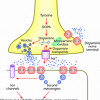*** This is my own personal ignorant opinion. I am a highschooler in 12th grade, not a Doctor! This is merely a hypothetical hypothesis I proposed after reading a few things on ketamine and scopolamine. This is not a replacement for medical treatment and is not intended to treat cure or prevent any disease. ***
With that said, Let the discussion begin!
Recently, scopolamine has been receiving attention for its possible antidepressant efficacy. For example, Drevets WC and Furey ML published a paper in Biological Psychiatry (2010) concluding “These results replicate previous finding that scopolamine produces a rapid and robust antidepressant response.” (Drevets WC & Furey ML, 2010) It is believed that, “the muscarinic receptor subtype might be the most relevant to the potential antidepressant mechanism of action of anticholinergic drugs.” (Howland RH, 2009) Therefore, since diphenhydramine is a “fairly potent muscarinic antagonist” (Huiling liu & Jerry M Farley, 2005), and the muscarinic receptor is probably most likely mediating the antidepressant effect of anticholinergic drugs (Howland RH, 2009) than, diphenhydramine should be capable of mediating an antidepressant effect that mirror scopolamine via both acting as muscarinic antagonists. (Huiling RH & Jerry M Farley, 2009) Further more, since mTORC1 signaling is required for scopolamine to exert its antidepressant action (Voleti B Et Al., 2013) than, diphenhydramine should also be able to induce this mTORC1 signaling when dosed sufficiently. Also, since both NMDA antagonists and scopolamine require mTORC1 signaling to act as an antidepressant (Voleti B Et Al., 2013) than, if GSK-3 inhibition potentiates the antidepressant-like effect of subthreshold doses of ketamine (Liu RJ Et Al., 2013) it should also potentiate the antidepressant-like effect of muscarinic antagonism via both sharing the overlapping “requirement of mTORC1 signaling.” (Voleti B Et Al., 2013) And, that lithium carbonate is capable of acting as the GSK-3 inhibitor. (Liu RJ Et Al., 2013) Also, that the use of aniracetam may be able to potentiate the effect of muscarinic antagonists as “scopolamine 0.03 mg/kg IP enhanced aniracetam 100 mg antidepressant effects in aged rats”. (Nakamura K & Tanaka Y, 2001) Lastly, since the activity of mTOR is controlled by insulin, growth factors, amino acids (especially leucine), and oxidative stress (Do-Hyung Kim Et Al., 2002) than, manipulation of these should allow a possible increase in the mTORC1 activation induced by muscarinic antagonism and, therefore, possibly enhance the antidepressant response.












































